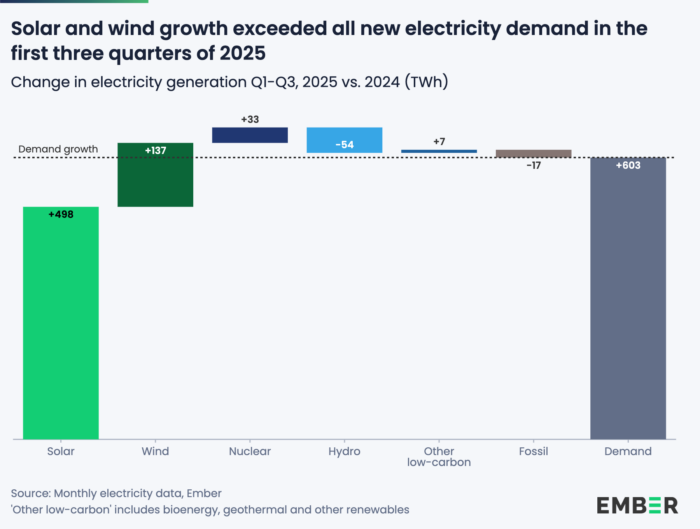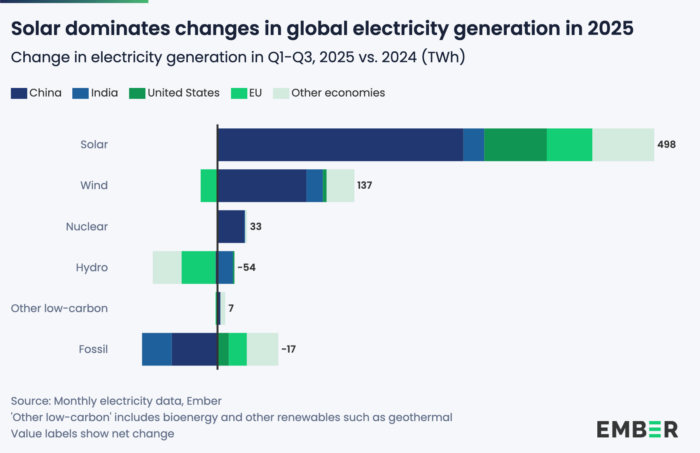At the UN climate talks currently taking place in Brazil, a big ticket item on the agenda is the push for tripling global renewable energy by 2030. This was a pledge made by countries at COP28 in Dubai, two years ago and is now on everyone’s lips: in speeches, in negotiations, in the demands from young people outside the halls and the communities harmed by fossil fuel systems for decades.
And for good reason too. Renewables like solar and wind not only cut emissions, but because they bring jobs, stability, and fairness to a world shaken by fossil fuel-induced social, economic and climate chaos.
This momentum for renewable energy at COP30 is now accompanied by pretty solid evidence. Two major releases show that the transition to clean energy is not something the world is preparing for, it is something the world is already doing. The first is the Global Power Report, from the global energy think tank Ember. The second is the World Energy Outlook 2025, by The International Energy Agency (IEA), one of the world’s top energy bodies.
Ember’s report shows something historic: renewables are now powering all new electricity demand
- Renewables met all new electricity demand in 2025: Solar generation jumped an incredible 31%, adding a record amount of electricity, while wind kept growing steadily. Together, they grew faster than the world’s rising demand for electricity. Even with droughts reducing hydropower, clean energy still met the world’s rising electricity needs. For the first time outside a crisis year, fossil fuel use didn’t increase because renewables grew fast enough to fill the gap. That’s real progress. And this shift is not just happening on paper. Across Africa, community-led initiatives like RePower Afrika are already bringing small-scale solar to hospitals, schools, and villages once dependent on fossil fuels.

- Fossil fuels are flatlining, even in the world’s biggest countries: Ember expects zero growth in fossil-fuel electricity for all of 2025, despite one of the largest jumps in power demand ever. China and India, traditionally the biggest fossil consumers, led the change. In China, fossil generation fell by 52 TWh because clean energy covered all new demand. In India, fossil generation dropped 34 TWh, thanks to record solar and wind growth and milder weather that cut cooling needs. Although these gains did play a part in balancing out the fossil fuel increase in the EU and the U.S.
- Solar is now the engine of the global power system: In just nine months, solar power produced more electricity than in all of 2024. It grew three times faster than any other energy source, with China alone responsible for over half the global increase. Solar and wind together now generate 17.6% of global electricity, and all low-carbon sources combined have reached 43%. For the first time ever, renewables produced more electricity than coal.

The world’s top energy experts agree: renewables and electrification will soon dominate
The latest data from Ember lines up with its analysis of the findings from the IEA World Energy Outlook 2025, one of the most influential energy reports in the world.
While the IEA doesn’t make predictions, its scenarios show a consistent direction across the board: renewables are growing fastest, electrification is accelerating, and fossil fuels are losing their grip on the global energy system.
- In the IEA’s main policy scenario, solar and wind rise from 15% of global electricity today to 39% by 2035. Electricity demand will grow seven times faster than total energy use which is proof that homes, transport, and industry are rapidly going electric. Meanwhile, fossil fuels will fade: coal drops sharply, oil declines slightly, and gas barely grows at all.
- But Ember’s deeper look shows the IEA may still be too cautious, likely underplaying just how fast change is happening. Technology is moving more quickly than policy. Global manufacturing of solar panels, batteries, and electric vehicles is already outpacing the IEA’s assumptions.
- Ember’s analysis also confirms that fossil fuel demand has already peaked in key sectors: industrial use since 2014, buildings since 2018, and oil for road transport since 2019. The IEA’s main scenario shows coal is set to peak before 2030, with oil close behind. Meaning now fossil fuel use can only decline.
- The next wave of growth will come from sun-rich regions including the Middle East and Asia where solar power is cheapest and battery storage makes round-the-clock clean electricity possible. The IEA estimates that 80% of future energy demand growth will come from these emerging markets, places where renewables not only cut costs, but also boost energy security and independence. In fact small micro-hydro cooperatives are already proving what this looks like in countries like Indonesia, with rivers powering local mills and schools while communities share profits and protect forests. These bottom-up models show how energy independence can grow from a single stream.

Communities in countries like Indonesia (pictured here) are already moving towards energy security through small-scale renewable energy projects, like micro hydro dams. Credit: 350.org
- And what about AI, the new energy-hungry technology ? The IEA finds its impact on electricity demand will be significant in the U.S., but much smaller across the EU, China, and developing economies.
Net Zero Scenario
The IEA also maps out a Net Zero Emissions by 2050 Scenario (NZE). This is a plan showing what the world could look like if governments and industries truly follow through on their climate promises and limit global heating to 1.5°C, the key target set under the Paris Agreement to avoid the worst impacts of the climate crisis. The Scenario is the IEA’s way of saying: If the world actually followed through on its climate promises, here’s what the energy system, and people’s lives, would look like.
In this Scenario, the benefits are clear:
- Households in wealthier countries would pay less for energy as renewables replace volatile fossil fuels.
- Emerging markets will keep costs stable while strengthening energy security and independence.
- The world will avoid dangerous heating by rapidly phasing out fossil fuel dependence.
- Electricity access will expand to the 730 million people who still live without electricity today, and to the 2 billion who currently rely on toxic cooking methods.
COP30 must be a springboard for the clean energy revolution
The data speaks for itself: the clean energy transition already here, and it’s accelerating. This is the momentum the world brings into COP30. Now, leaders at COP30 have a choice. They can build on the progress already happening across grids, communities, and entire economies or they can slow it down at the exact moment clean energy is proving it can deliver. We are calling on them to:
- Supercharge renewables in a fair and equitable way: The global pledge to triple renewable energy capacity by 2030 taken by countries during COP28 in 2023 has to become reality not rhetoric. That means replacing fossil fuels, and making renewable power affordable, distributed, and accessible to every community, not just the wealthy ones.
- Fully fund the transition from fossil fuels to renewables: Leaders must drive forward the COP29 Roadmap toward the USD 1.3 trillion climate finance target and speed up the delivery of public, grant-based, and debt-free funding. That’s what will allow countries to build renewable power, strengthen grids, and protect people on the frontlines of the climate crisis.